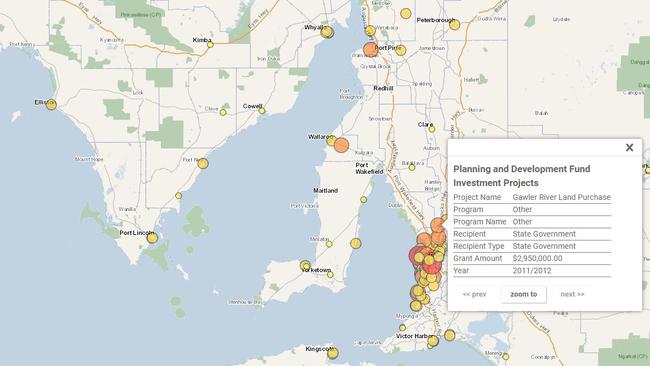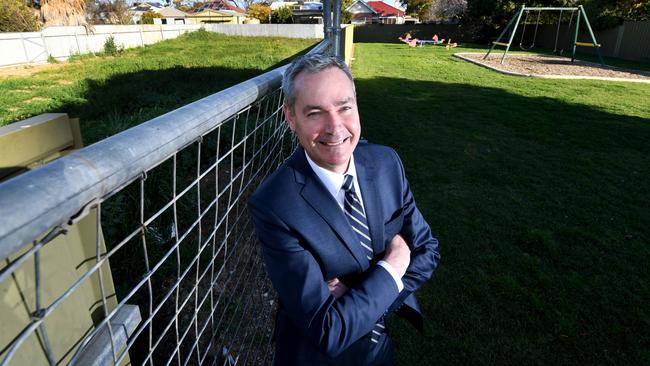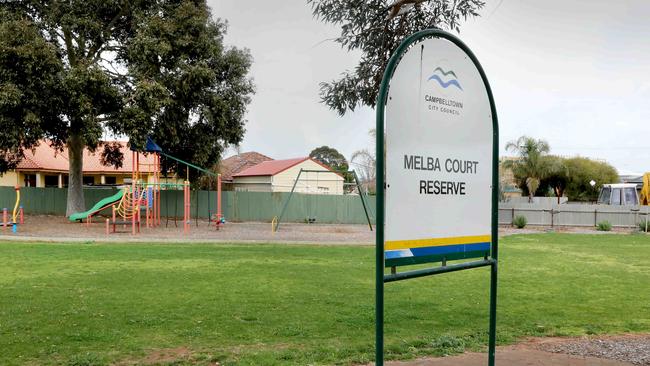MAPPED: The Adelaide suburbs missing out on millions of dollars in funding from developers for public parks
SUBURBS experiencing major housing renewal are missing out on million of dollars of developer-funded upgrades to public parks and open space: SEE THE STATUS OF YOUR SUBURB.
SUBURBS experiencing major housing renewal are missing out on million of dollars of developer-funded upgrades to public parks and open space sparking calls for a more equitable distribution of cash.
The State Government has distributed more than $150 million in the past eight years towards open space and streetscape upgrades funded through mandatory taxes paid by developers into a so-called planning and development fund when they subdivide land.
An analysis by The Advertiser of spending from the fund has revealed that a quarter of funding — or $38 million — has been spent in the CBD on projects such as Parklands playgrounds and city street upgrades.
But residents of Campbelltown Council and West Torrens Council, whose suburbs are also experiencing significant major urban infill through their neighbourhoods, have received $286,000 and $505,250 respectively — among the lowest in the state.
This is despite developers in those councils contributing $8.37 million and $6.9 million respectively in levies between 2010 and 2017, according to latest figures from the Planning Department.

Sources: DPTI/UniSA
Under the Development Act land owners who create 20 or more allotments must set aside up to 12.5 per cent of land in the affected council area as open space or pay an agreed levy to the council.
But where fewer than 20 allotments or strata tilted units are created — as is the case in the majority of urban infill projects and apartment developments - developers pay up to $7253 for each allotment into the planning fund.
Councils and community groups then apply for funding with no guarantee their projects will be successful.
Urban Development Instiute of SA executive director Pat Gerace said the fund should be reviewed to ensure that money is going where it is needed.
“We said in the lead up to the election that the Government needs a total review of the open space scheme to make sure it better reflects the needs of community, and importantly makes the best use of the significant financial contribution that developers already make,” he said.
“Primarily, changes need to be made on how the funds collected by state and local government can be better directed to the areas where development occurs so they are used for their intended purpose.
“Some of the large projects completed from the fund aren’t geographically related to where it (money) comes from, but just where the Government chooses to use them.”
MAP: EXPLORE OPEN SPACE PROJECT FUNDING 2010-2017

A UniSA analysis of usable open space - that is areas that don’t include road reserves and median strips - determined that 134 suburbs in SA were below an industry guideline of 4ha/1000 people.
A large tranche were in areas covered by Campbelltown, West Torrens Council, Unley, Port Adelaide Enfield and Marion councils.
Flinders University urban geographer Dr Gerti Szili said the fund, established in the 1960s, was critical in conserving existing open space and enhancing existing open space, which she said was particularly important for metropolitan Adelaide given the impetus on urban infill.
But she said the formula for providing was potentially outdated.
“For example, if there are land parcels of 20 allotments or less, with separate land owners, and there is no open space provided due to the size of the allotments, this could lead to a major gap in provision,” she said.
“The current funding scheme is only available to new projects, which threatens the efficacy of continued improvement and development of open space projects which may have faced budgetary or administrative issues.”
Parks and Leisure Australia SA/NT branch executive offier Allison Bretones said the fund has been “really good” at funding large developments but “I don’t think it’s been equitable for the councils now experiencing the consequences of the urban density and urban infill”.
”Open space grants tend to be allocated for projects that have greater benefit than (just) the local community,” she said. “It’s difficult to get a grant for purchasing open space.”
Campbelltown Council had advocated in 2013, as part of State Government planning reforms, that all funding generated from developments should quarantined to the council where development was happening.
“If implemented as part of the reforms this would have allowed council to generate funds to purchase land in areas of development where there was insufficient open space or develop existing open space to accommodate the increased pressure on its usage as a result of this extra development,” council staff said in a September 4 report to council.

Unley Council, which has the state’s lowest proportion of open space at just .8 sqm for each of its 38,500 residents has received $616,500 in grant funding since 2010 but developers in the region have paid $1.5 million in levies into the fund over the same period.
Acting mayor Peter Hughes said the funding mechanism should be reformed to perhaps allow the council to retain half of funds generated from subdivision levies.
“We are seeing very little of that money return to the city and we have a desperate need for the development of our open space, but the government, in its wisdom, allocates funds where they think the biggest needs are,” he said.
“We have got intense pressure on our existing sports facilities and we don’t have many of them.”
Planning Minister Stephan Knoll the operation of the fund had not been raised with him since he became minister.
“We are constantly reviewing the effectiveness of all funds to ensure they deliver the best outcome for South Australian taxpayers,” he said.
SEARCH FUNDING BY COUNCIL AREA
INNER-METRO COUNCILS OPEN SPACE
(Population/Ha per 1000 people)
Adelaide - 20,000/49.5
Mitcham - 66,834/8.20
Campbelltown - 49,716/7.97
NPSP - 34,000/5.3
Burnside - 41,175/4.84
Walkerville - 7000/4
Charles Sturt 104,981/3.84
Port Adelaide Enfield - 112,812/3.64
West Torrens - 54,948/3.1
Prospect - 20,000/1.2
Unley - 38,500/0.8
Metropolitan Average: 8ha/1000 people (industry benchmark 4ha/1000 people)
Sources: Burnside Council Open Space Strategy 2008-2018, Campbelltown Open Space Strategies and Directions Report June 2012, Charles Sturt Council Open Space Strategy 2025, Port Adelaide Enfield Open Space Plan 2013, West Torrens Open Space and Public Place Plan 2013, Prospect Council Draft Open Space Strategy Feb 2018, NPSP Council, Mitcham Council
‘YOU DON’T GET MUCH OUT OF A MILLION BUCKS’
OLD houses demolished and replaced with two or more modern buildings is a scene being repeated across Prospect amid the push to get more people living closer to the city.
But a recently flattened 1940s-era three-bedroom house on Charles Street has instead been sacrificed to expand a neighbouring playground.
Prospect Council billed ratepayers $680,000 for the 692 sqm property near busy Churchill Road in June last year and will invest several hundred thousand more upgrading the site which adjoins Stan Watson Reserve.
Mayor David O’Loughlin said it would be the first expansion of public parks in the council area in decades.
“By the time you add it all up converting one house into a park, you don’t get much out of a million bucks … that’s painful,” he said.
The council area has among the state’s lowest proportion of open space for its residents, at 2.1 ha for every 1000 people.

Mr O’Loughlin said he would like funds from the planning and development fund used more strategic purchase of property for open space expansion.
“The fund is rarely used to purchase new open space, in the inner metro area you can’t purchase new open space, you’ve effectively got to buy an existing property … and knock it over and turn it into a park,” he said, citing that urban infill was making land increasingly more expensive.
He said the planning and development fund had been “very good” at increasing quality open space in inner metropolitan areas and in particular upgrading of major streets such as Prospect Road.
“Main streets were dead 15 years ago and that funds been an important part of bringing them back to life, that’s what’s happened here on Prospect Road,” he said.
In the long term the council he said will create an open space strategy that could involve the possible sale of parks and investment in others.

“No one really likes to see them sold, but sometimes they are too small or we’ve got a couple on the corner of Main North and Regency Rd for example you wouldn’t let your kids play on because it’s right near the traffic lights,” he said.
Campbelltown Council has bought four properties in recent years which have either been incorporated into existing parks or strategically acquired for future expansion of open space.
Among them was a run-down home at Melba Court, Hectorville which cost the council $750,000 at auction in 2016 and was merged into an adjoining park.
The council has identified that Hectorville and parts of Campelltown, Rostrevor and Tranmere in Adelaide’s northeast, having the least amount of parks in its area with just .9ha per 1000 people.
Chief executive Paul Di Iulio said the council looks to buy sites next to its existing assets “especially where we know there is a shortage of open space”.
Stories Renato Castello
-Maps/database Greg Barila
